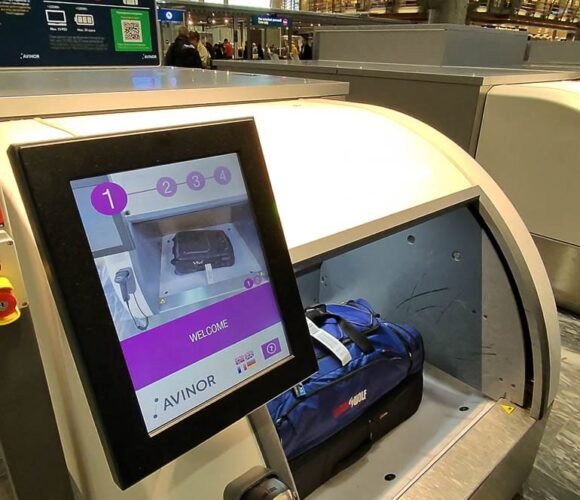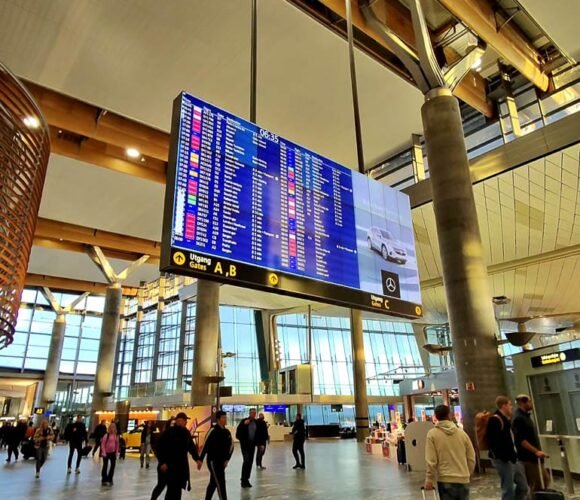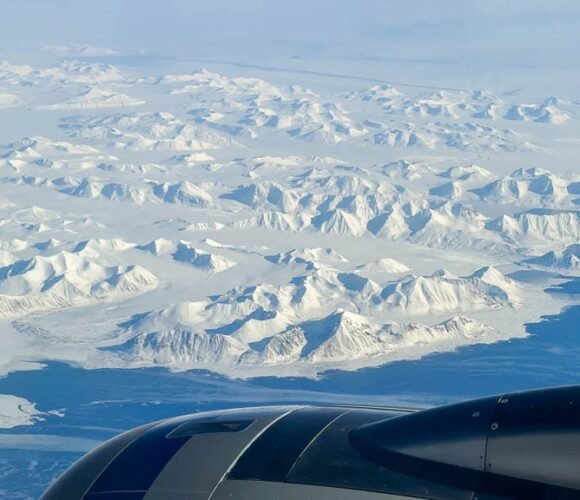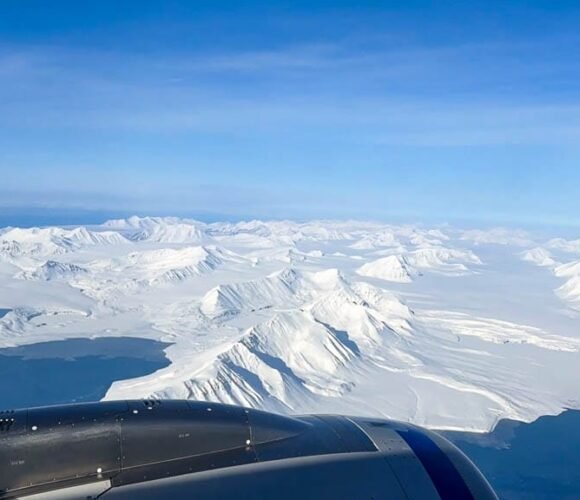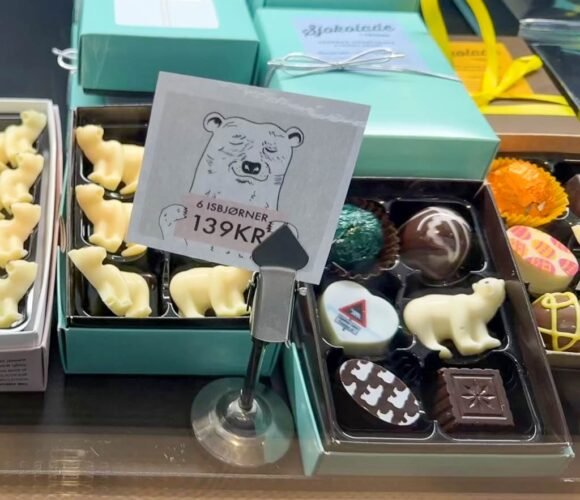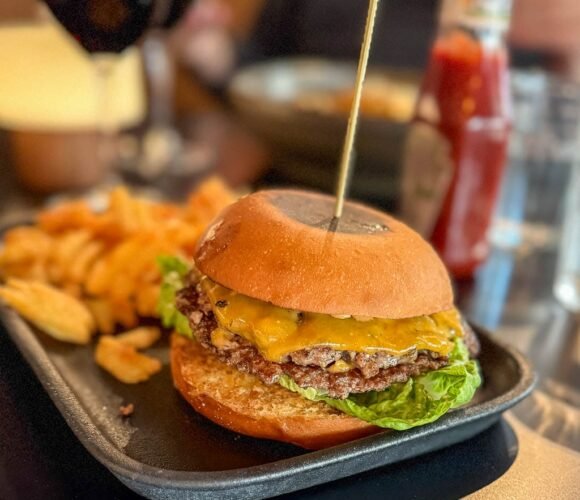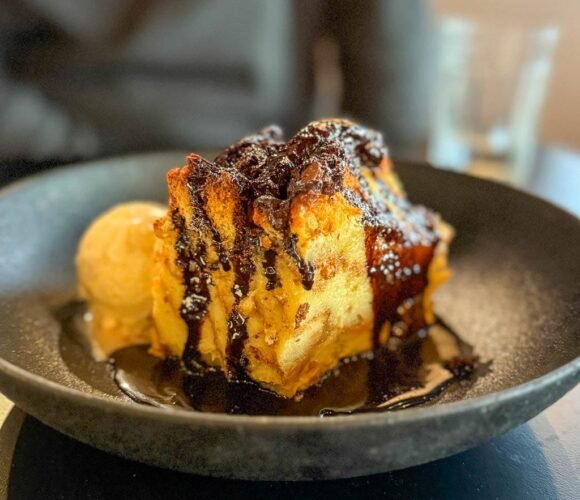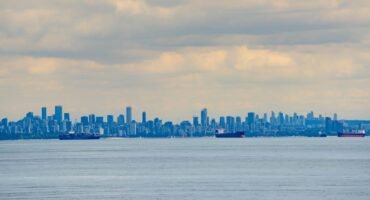
How to Get to Svalbard (and what to do once you are there)
- Svalbard Photography Expedition
- How to Get to Svalbard (and what to do once you are there)
- Svalbard Photography Tour
- A Snowmobile Trip to East Svalbard
- Svalbard Photography Expedition on the M/V Freya
- Landscapes of Svalbard
- Harp Seals in the Sea Mist
- Falling in Love with the Arctic Walrus
- The Bearded Seal - A New Favourite
- Minke Whale Surprise
- Polar Bears (a.k.a. pixel bears)
- The Birds of Svalbard
- Reflections on Our Trip to Svalbard (and Svalbard Departure Tips)
Svalbard is pretty easy to reach from Oslo — but if you’re coming from Australia, you are basically travelling to the opposite end of the planet.
How to Get to Svalbard
I honestly had no idea how to get to Svalbard. I didn’t even know what airport to search. From Melbourne, the most direct route is via Dubai, which meant flying Emirates instead of our usual Qantas. Because we booked fairly last minute, the flight was packed and all the good seats were already taken. I know we’re incredibly lucky to travel as much as we do (and usually snag upgrades), but 14 hours in economy was brutal.

We had a 2.5-hour layover in Dubai. This was just enough time to freshen up in the lounge and grab breakfast before boarding a 7-hour flight to Oslo. The exit row helped, but the flight was so empty that I ended up claiming a whole row. It may have been “bogan business class,” stretching out across four seats, but I have no regrets.
Layover in Oslo
Arrival in Oslo was a breeze. At passport control, the border agent glanced at our passports and said, “You’re certainly a long way from home!” (a theme for this trip, as we quickly learned). Our bags showed up immediately, and a free luggage cart made the five-minute walk to the Radisson Blu hotel easy. Thankfully, our room was ready even though we arrived before check-in. I know you’re supposed to stay awake to beat jet lag, but after 27 hours of travel, we crashed hard — woke up briefly at 8 p.m., rolled over, and next thing I knew it was 3 a.m.
Breakfast wasn’t included at the hotel, but after skipping dinner, we were starving. $40 for the buffet felt painful (especially since I wasn’t feeling great so didn’t eat much), but convenience won as it opened at 5am.

Oslo Airport is impressively efficient — one kiosk for all airlines, intuitive bag drop, and smooth boarding.
Security was the only snag; they made us pull out every piece of camera equipment and place them in separate bins. At the gate, the agent smiled at our passports and said, “Wow, you’re a long way from home — don’t touch the white bears!” (good advice, honestly).
The flight to Longyearbyen was a quick and easy three hours. We had window seats across the aisle from each other, and the views of snow-covered mountains and endless Arctic landscapes were absolutely breathtaking.
Arriving in Longyearbyen
When we landed in Longyearbyen, we were the only passengers who didn’t whip out winter gear from their carry-on. After the plane was sprayed with chemicals to keep ice from forming on the wings, we descended the stairs into -16c. I don’t even know how to convert negative C into F – but it was cold. Luckily it was just a short walk to the terminal.
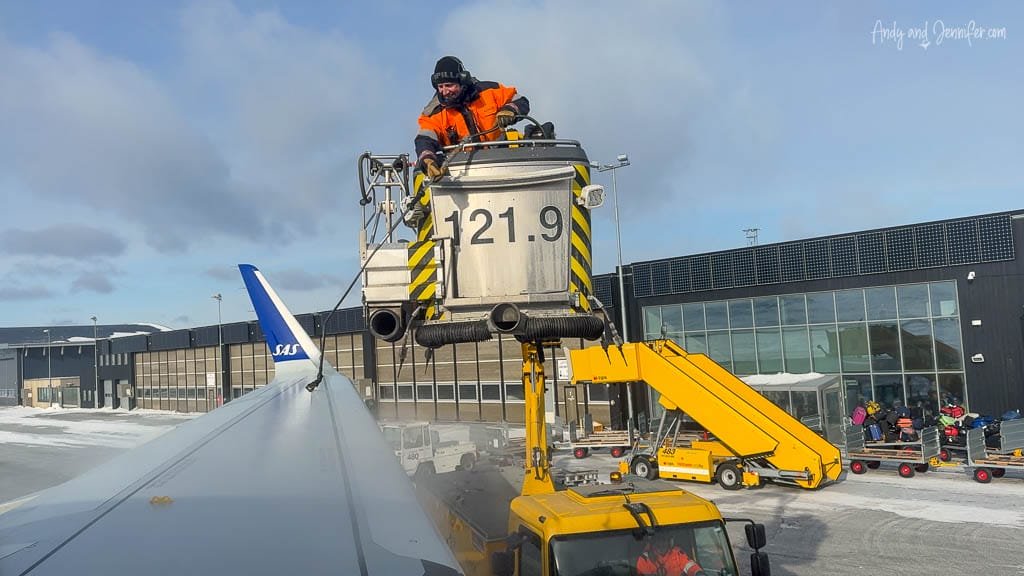
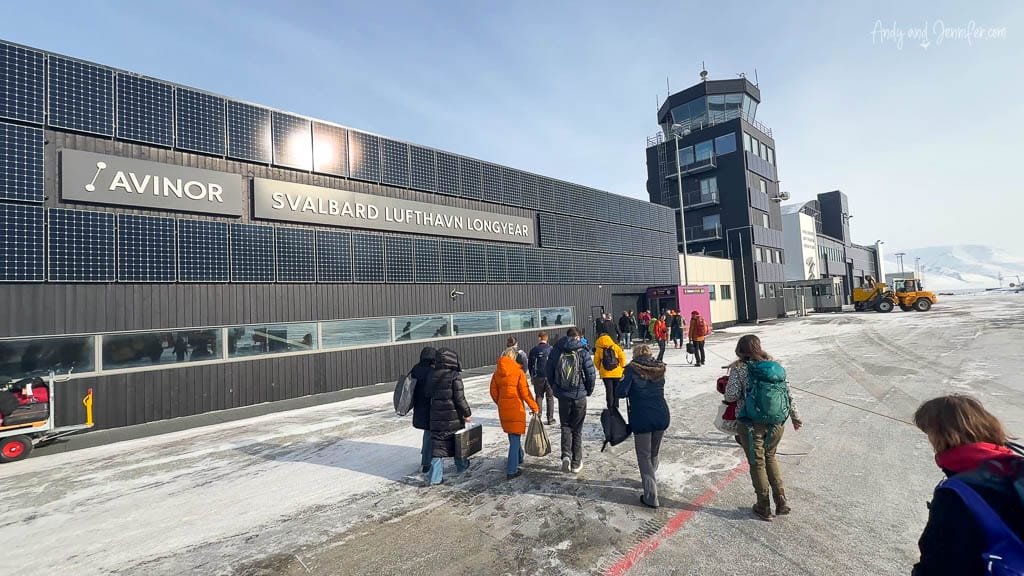
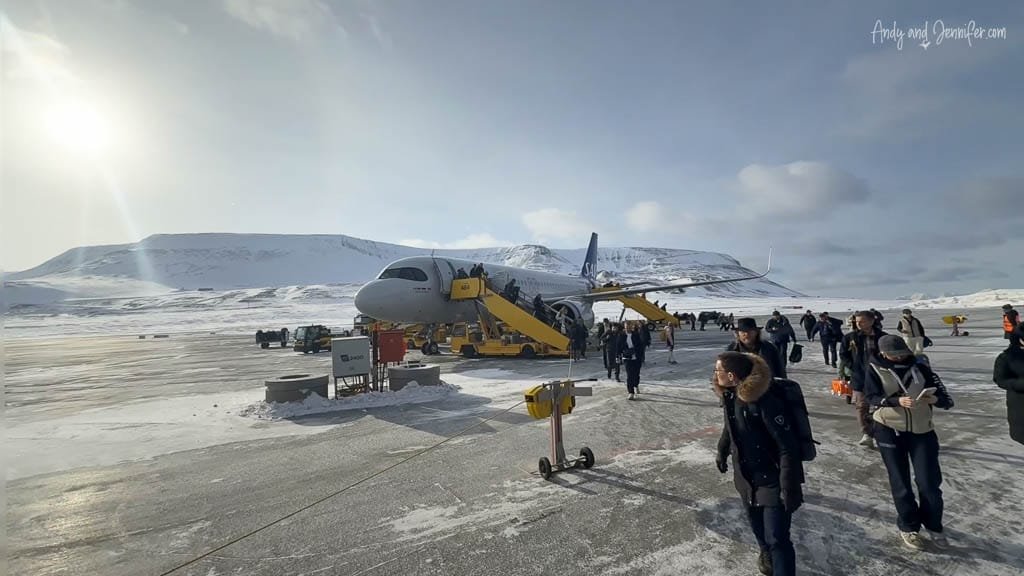
While waiting for our luggage I noticed the world cities signpost out front, with the famous polar bear warning sign. Sydpolen (Sydney) showed as 18,692 km away, which meant Melbourne would be over 19,000. It definitely felt like the other side of the planet.
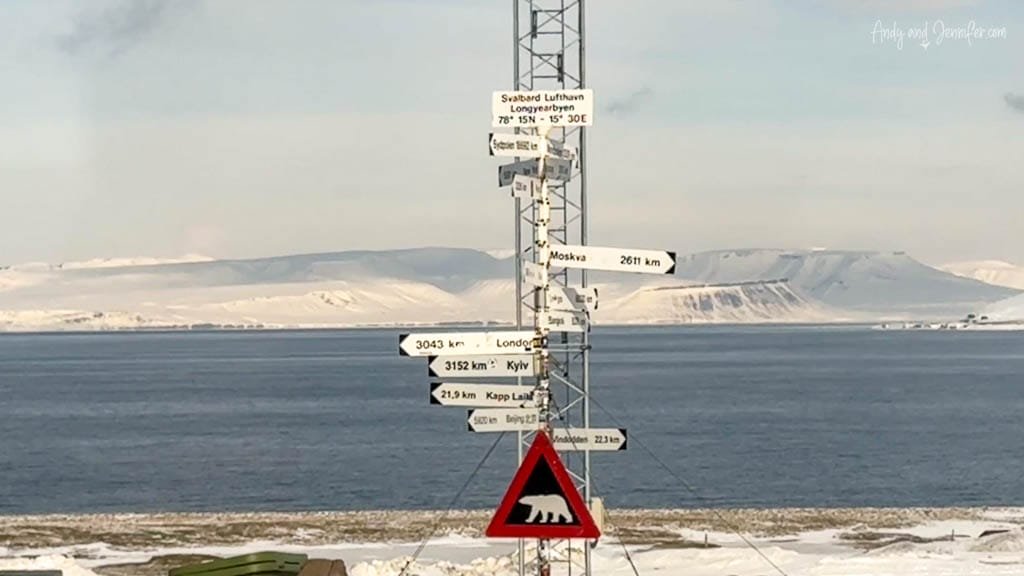
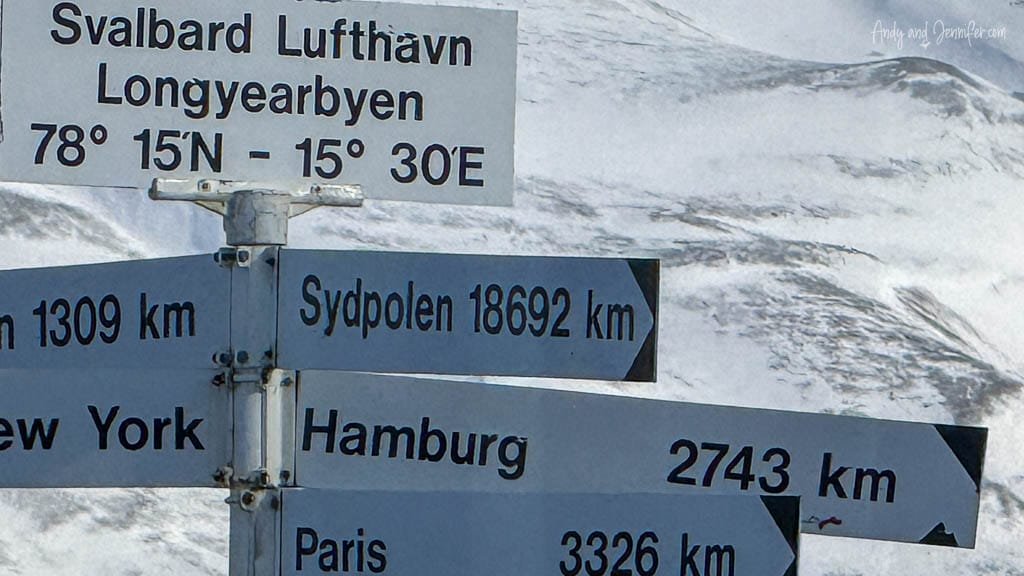
Getting Around in Svalbard
The settlement in Longyearbyen is relatively small – about 3 to 5 square kilometres. For context, this is roughly the size of Bondi Beach or Central Park.
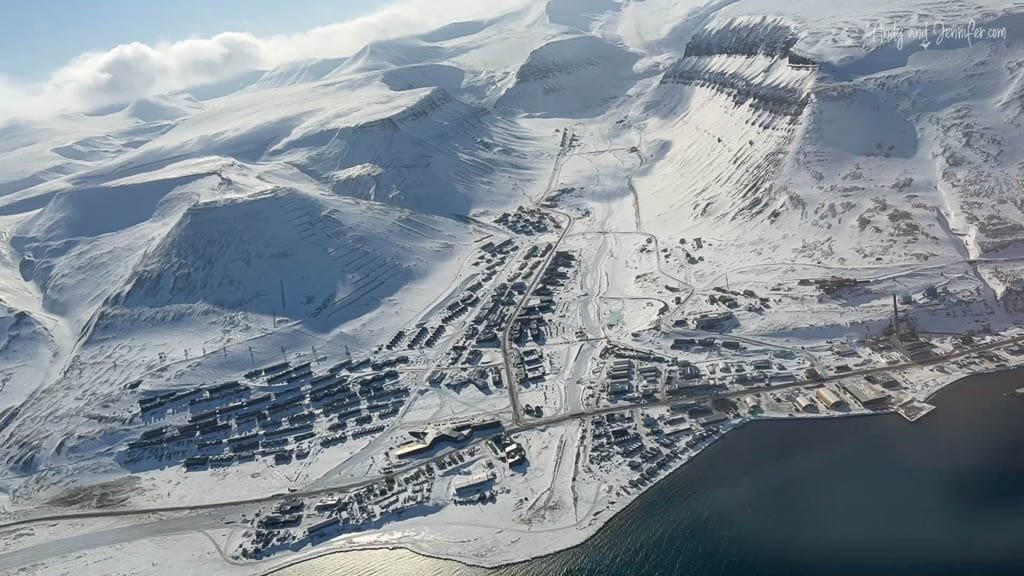
From the airport, there are two ways to get into town: taxis or the bus.
We originally planned to grab a taxi, but the one taxi waiting couldn’t take us. While they promised to come back, standing around in the Arctic chill was not a great way to start the trip.
Pro tip: there are only about four taxis in all of Longyearbyen — if you need to be somewhere at a certain time, definitely pre-book. The phone number is on their website. They take credit cards and the fares are reasonable – we paid between $12 (to the port) and $18 (to the airport).
The bus driver asked for our destination, and I awkwardly pronounced “Hotel Polfararen” with one to many syllables. The bus was super efficient, with plenty of space underneath for luggage. Tickets cost 100 NOK per person (about $9–10 USD), and you pay by credit card. In fact, credit cards are a must in Svalbard, since many places don’t accept cash at all. Our hotel was the first stop — just a quick 10-minute ride from the airport.
Where to Stay in Longyearbyen
We originally booked the boutique Funken Lodge — it had great reviews and looked cute and quirky. But when we needed to extend our stay by a day, only the pricier rooms were available and I couldn’t justify the price. So, we pivoted and booked the Hotel Polfareren. Svalbard is ridiculously expensive due to supply and demand. Our “standard plus” room was almost $400 USD.
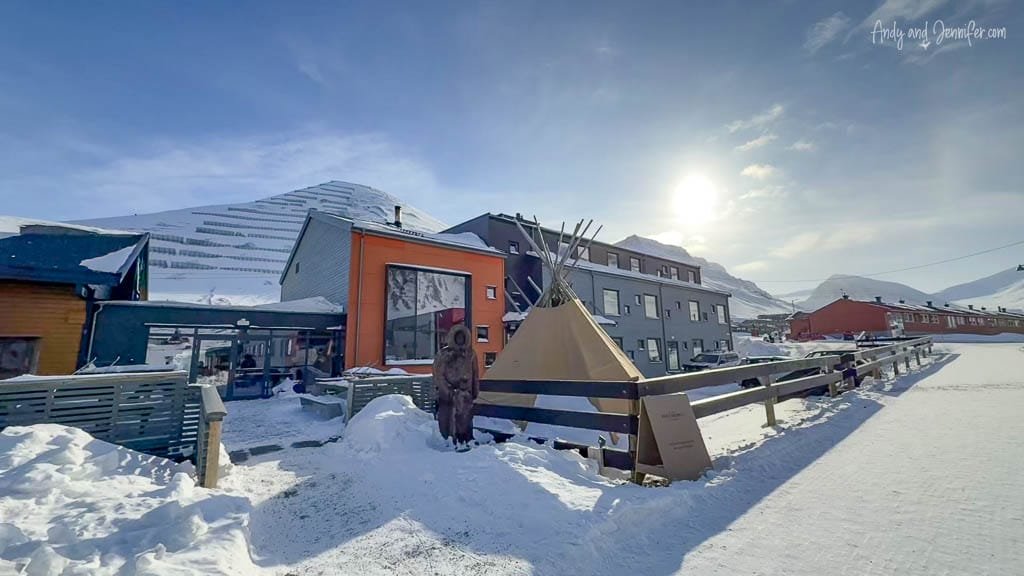
The hotel is actually a cluster of several buildings, so where your room ends up can vary. We were in the main building, just off the lobby, which turned out to be super convenient.
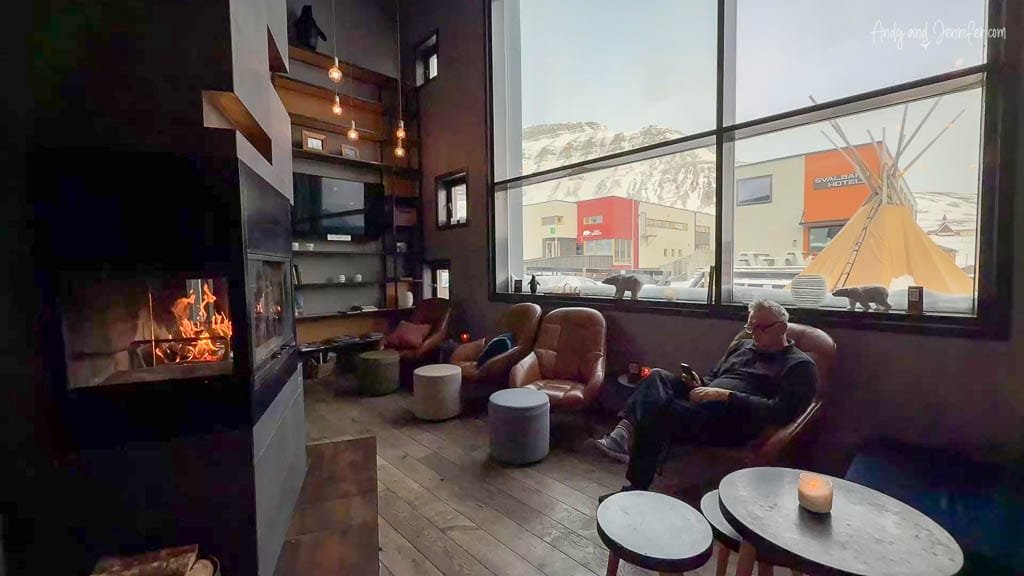
Our room had that signature Norwegian bedding style. It looked like a king bed, but had two single mattress toppers and separate doonas (duvets). The heated bathroom floor was a nice touch, and thanks to the dry Arctic air, anything we hung up dried almost instantly. Why is it that I always forget to take a room photo before we mess it up ?!?
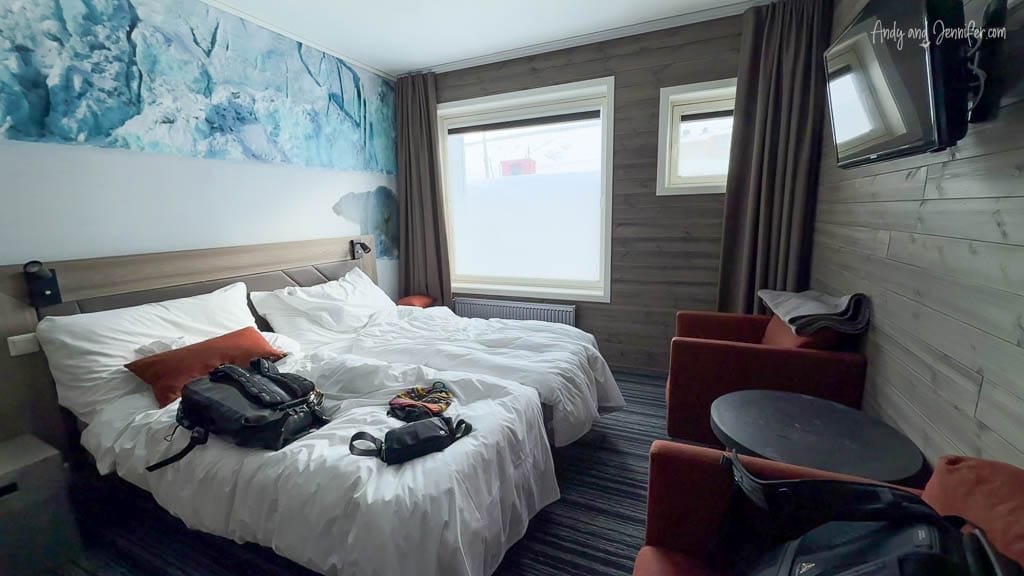
One fun cultural quirk: in Svalbard, it’s customary to remove your shoes when entering buildings — sometimes. Our hotel had a dedicated shoe room right off the entrance, complete with heaters for drying wet boots and a stash of slippers to borrow.
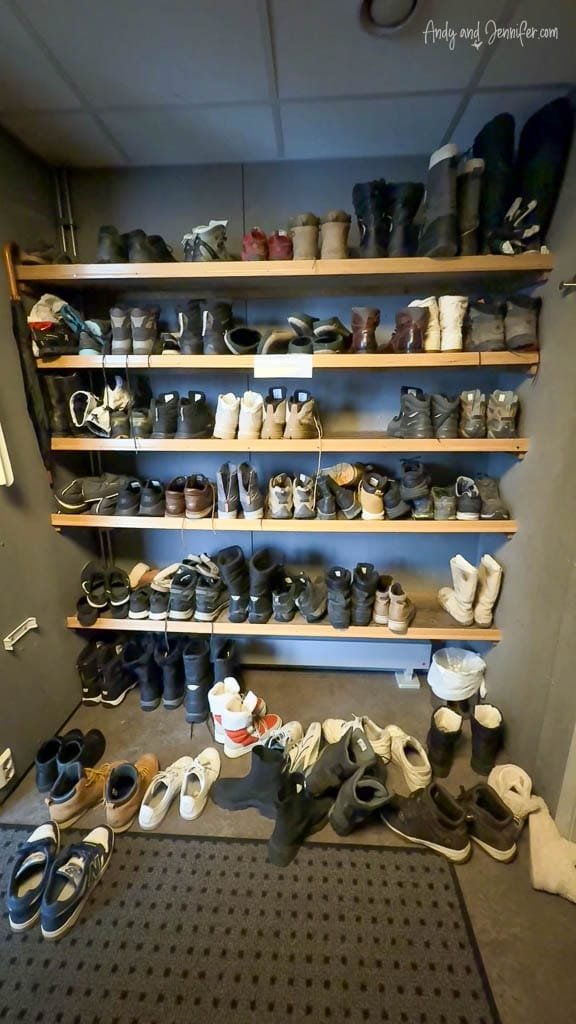
Breakfast was included with our stay, and included a mix of European (eggs, beans, toast) and local treats (herring along with mackerel and caviar paste).
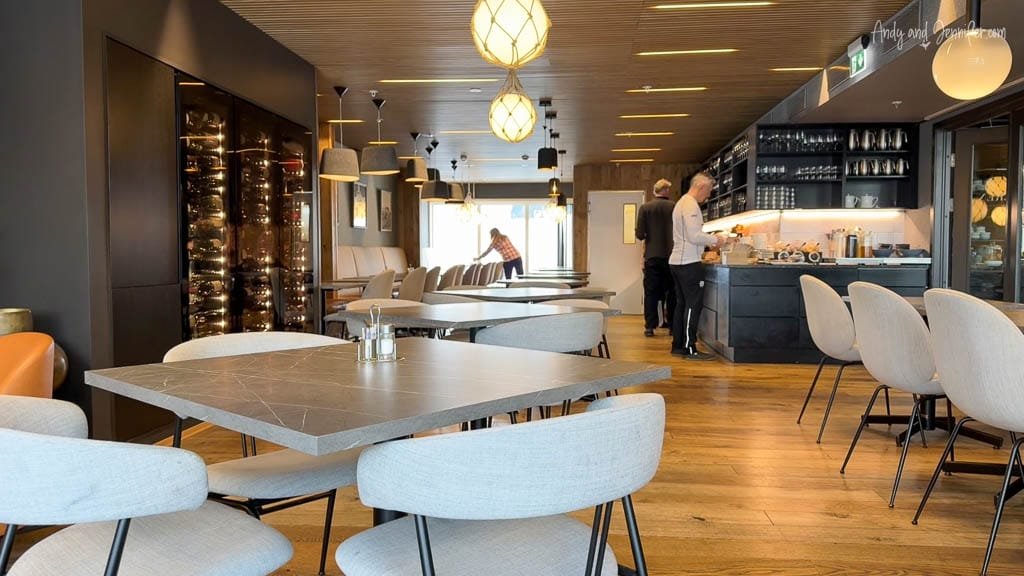
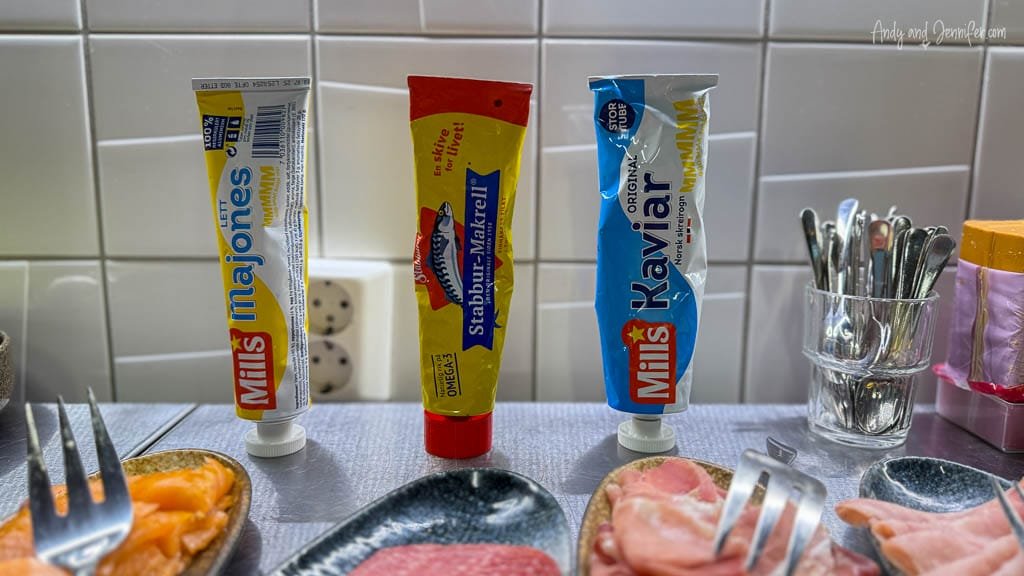
The location was fantastic — right on the main pedestrian street, with an easy walk to shops, cafes, and restaurants.
We did walk up to see the Funken Lodge. While it had a nice view, it would’ve been about a cold and icy 15-minute walk to get to the shops.
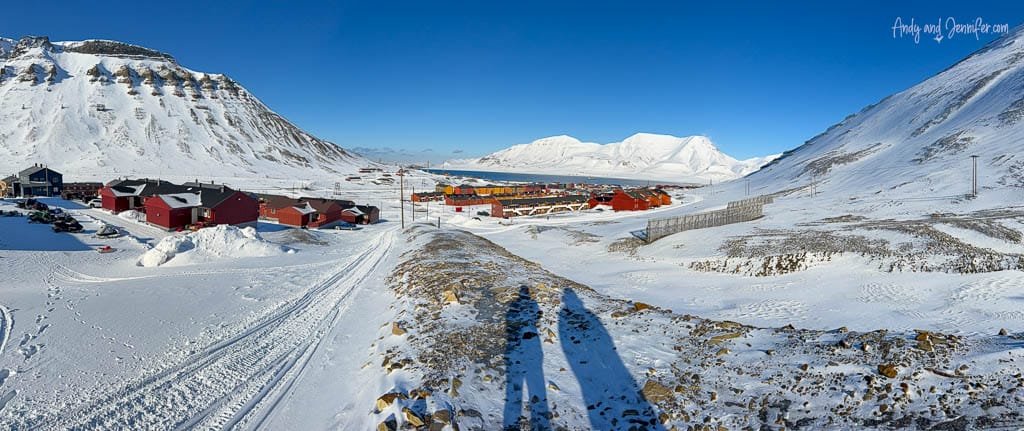
WHAT TO EAT IN SVALBARD
For such a remote place, Longyearbyen has a surprising number of dining options. That said, there were a lot of dishes I (as a non adventurous eater) would classify as weird. For example, smoked minke whale, moose burgers, seal tataki, and reindeer roulade.
Unlike much of mainland Europe, restaurants in Norway tend to serve dinner early, with some kitchens closing by 9 p.m. Even though it was still very early in the season when we visited, the restaurants were busy and tables filled up fast, so make a booking or risk being turned away.
Here’s a quick rundown of where (and what) we ate:
- Fruene — Located inside the main shopping mall, Fruene became our go-to spot for coffee, soup, and sandwiches. They also sell a beautiful selection of wool products.
- Stationen — Also in the main shopping area, this casual spot serves great toasties (toasted sandwiches) — perfect for a quick and hearty lunch.
- Svalbar — Between the shopping mall and Hotel Polfareren, Svalbar is known for its smashburgers.
- Kroa — Conveniently located right next to Hotel Polfareren, Køen serves really good pizza. Just a heads-up: a half pizza is more than enough for two people.
TIP: Don’t overlook the local grocery store in Longyearbyen! It’s not just handy for snacks or DIY meals — it’s also a goldmine for unique souvenirs like collapsible water bottles and polar bear blankets. Plus, the self-checkout system is super easy to use (honestly smoother than most Aussie supermarkets!). Just remember to keep your receipt which you need to scan to exit.
WHERE TO SHOP IN SVALBARD
One of the biggest challenges in preparing for this trip was finding proper winter gear in Australia. We were advised to bring windproof/waterproof parkas and boots, both rated for -30°C (-22F). At first, we thought our parkas from Antarctica would do the trick, but April in Svalbard would be substantially colder than Antarctica in summer.
I had hoped to rent a parka and boots (mainly because they’re bulky to travel with and probably wouldn’t get much use after this trip). Rental options were practically nonexistent. One place did rent boots, but their “season” didn’t start until June and the boots they had “weren’t warm enough for April.”
In the end, we found the essentials — parkas and boots — online. Neither were exactly our first choice, but they would hopefully do the job. I didn’t want to waste time shopping in Svalbard itself, worrying about stock, sizing, or blowing the budget.
Ironically, once we got there, we realised you can buy anything you might need in Svalbard — from expedition-grade jackets to Arctic boots — and there’s no VAT (tax). That said, gear was still expensive. After a couple of cold day trips (more on that soon!), we decided we needed balaclavas and insulated pants. The insulated pants ran about $300 AUD — for comparison, that’s the same price I paid for basic rain/wind pants at Paddy Palin in Australia.
WHAT TO DO IN SVALBARD
We had three days in Svalbard before boarding the ship, so we pre-booked two activities: a half-day photography tour and a full-day snowmobile trip out to East Svalbard. On our final day, after checking out of the hotel and with a few hours to kill before embarkation, we visited the North Pole Expedition Museum and a pop-up exhibit by Polar Bears International.
North Pole Expedition Museum
This small but fascinating museum focuses on the early attempts to reach the North Pole, with a special emphasis on the airship expeditions of the 1920s and 1930s. Did you know that early explorers basically used giant floating blimps with engines? I didn’t. I also didn’t know they were called dirigibles. The museum was packed with vintage photos, original equipment, detailed maps, and newspaper clippings from the era. And you have to leave your shoes at the entrance but you can borrow crocks.
Polar Bears International Exhibit
We spotted a flyer for a Polar Bears International (PBI) pop-up exhibit at our hotel so decided to visit. The free exhibit was set up inside a clear plastic dome — the Ice House — near the North Pole Expedition Museum. The exhibit featured photography by the leader of our trip to Churchill years ago. Small world!
Inside, we learned more about how scientists track polar bears — including the fact that only female bears are collared because the males’ necks are too thick compared to their heads. There was also a really interesting map showing the different polar bear populations across the Arctic. Plus, they had free stickers!
Next up — Half Day Photography Tour in Svalbard
We’re Andy and Jennifer—two former corporate executives who chose long ago to prioritise experiences over stuff while pursuing our passions for travel and photography. From the Arctic to Antarctica, and most places in between, we’ve captured the world through our lenses and love sharing those stories. Our careers gave us the means, but our purpose is inspiring others to explore and helping people create images they’re proud of.

